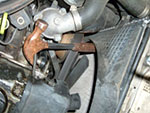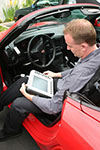Posted on 11/27/2012

As vehicles get more complicated, the diagnosis of problems is as always, very challenging. It has always been challenging but new twists and more advanced multiplexing and technology adds to the complexity. Somewhere, in the world of diagnosis, some customers don’t think that the perceived valve of diagnosis is worth the money. Throw in the fear of unknown and trust into this equation, it get some customers looking elsewhere for answers. Our shops, as some in the automotive business, spend weekends and evening in classes to learn about the new technology. In these specialty classes, just learning how to use new scanner and all the capabilities is time consuming. In the past two weeks, four of techs spent Saturday and Sunday in classes. Newer vehicles are the most complex object that most people own. We had a customer bring in his European import with a check engine light on and running poorly. We scanned it (hooking up a specialty scan tool) and found a P0301 code, misfire #1 cylin ... read more
Posted on 10/17/2012
Fall is here; time to get prepared for the rains and winter. Rain, snow, and ice all come with fall and winter. Your tires are your first line of defense between you and the road. Poor tires are just plain dangerous for you and the other people on the road. Make sure your tires are in good condition. Check your tire pressure, the pressure is determined by the automobile manufacturer, not the tire company. You will find your recommended tire pressure on the driver’s door jamb, glove box lid or in your owner’s manual. Coolant check, 50-50 mixture of antifreeze/water. That will bring it down to -34 the recommended level for winter and so the cooling system doesn’t corrode and rust. Battery check. A battery receives its electric energy from chemical reactions. The colder it is, the less power a battery has. And on top of this, a cold engine requires more power to crank it over. Cold weather is a test for a battery. Get your battery checked before it deserts you. A good battery has a lif ... read more
Posted on 10/16/2012

Check engine lights and code readers I write a lot about check engine lights. It is a huge subject. Every week, it is the most sought after repair that our shops do. A code reader, called a scan tool, can very an incredible amount. I have seen a universal scan tool for $29.95. The enhanced scan tool the Mercedes uses is about $18,000. The BMW scan tool is about $10,000 with a $1,200 a year up-date fee. Between the two shops, I have over $60,000 worth of scan tools. To put it simply, the amount of information you can extract from the vehicle. Tony from Transmission told me the last week, “I work for scanners” The government has legislation that dictates that emission related trouble codes must be available for a generic scanner. For us in the business, it is like putting together a jig saw puzzle upside down only getting the generic trouble codes. The better scanners (enhanced) give us such a better look into what it really having a problem. With most new vehicles, a generic scanner d ... read more
Posted on 10/16/2012
Your vehicle and sustainability. As the earth warms, global warming and sustainability has become a big news maker. People often ask me what they can do to help fight global warming and greenhouse gas (GHG) emissions. Some have gone so far to get a hybrid vehicle, others have taken to walking more, riding the bus while others are puzzled what they can do with little money that would make a difference. What I am going to suggest is how to get the biggest amount of good for the least amount of money. Not everyone can afford to buy a new car. The easiest way is to do very small steps. When a tire is not inflated properly, it requires more energy to make the car move and maintain speeds. An informal study found the majority of the vehicles in the US are only inflated to 80% of capacity. Property inflated tires can increase fuel mileage by 3.3%, an under inflated tires can lower fuel mileage by .4% per pound. Putting that an average driver who drives 12,000 miles per year, that would be ... read more
Posted on 10/16/2012
In the automotive business, we run across patterned failures almost daily. Just as a family will have the same health issues, cars from a particular maker can have common part-failure problems emerge over time. Back in 2002, I bought a brand new luxury car. I just loved it and still have it. At about 28000 miles, the transmission failed and deserted me in Portland. It was repaired under warranty but the whole episode kind of ruined our trip.. At about 45000 miles, I got a notice that the manufacturer who wanted to check and repair something for no change in the transmission even though I had no problem. This service was preformed. Then, as a person who faithfully maintains my vehicles, I changed the fluid with factory fluid at about 60,000 and 90,000 miles. At 97,000, the transmission fails again. The manufacturer knew that this transmission had a problem, extending the coverage to 100,000 or 6 years, whichever comes first. But I was out of time and luck. I got no help from the man ... read more
Posted on 7/26/2012
CNG, compressed natural gas, is the best alternative to gasoline, electric or hydrogen. I will make a bold statement, a CNG vehicle is the cleanest, least carbon foot print of any fuel power vehicle in the world. I say fuel powered to eliminate a human powered vehicle. The reason are vast, yes, an electric vehicle has less tail pipe emissions then a CNG vehicle but to produce and transport electricity, electric vehicles will has a larger carbon footprint then a CNG vehicle. Don’t even get me started about converting electric to separate water into hydrogen and then all the difficulties in storage of hydrogen. It takes about 3 gallons of to get the energy of 1 gallon of gasoline. In my opinion for the past 15 years, hydrogen powered vehicles are a bad idea! The first thing that needs to be established is the difference between energy source and energy storage. Gasoline, natural gas and solar are energy sources while electric batteries, compressed air and hydrogen are just a storage med ... read more
Posted on 6/20/2012
Last Thursday I attended an all-day seminar about natural gas vehicles (NGVs). According to Rick Wallace with the state of Oregon, NGV fleets in our region — including those operated by the Oregon State Department of Administrative Services Motor Pool, Salem-Keizer Transit and Port of Portland — are paying about $1.27 a gas gallon equivalent (GGE) for fuel, not including road taxes. Compressed natural gas, or CNG, is a very interesting alternative to gasoline. For one, the fuel is very available; the United States has a glut of natural gas. Another, more compelling advantage of natural gas is that it is much cleaner burning than gasoline or diesel. All vehicle types, even big 18 wheelers, could be fueled with CNG to produce much less pollution. These vehicles could be the cleanest-running vehicles on the road. Learn more about this in my July 16 column
Posted on 5/22/2012
Battery power electric cars have been around since the turn of the century but never been the mainstream. The biggest reason is that gasoline has so much energy in a gallon it makes it very difficult to compete against. Think about it, gasoline is convenient, relatively safe, easy to transport and store and huge, huge volumes are available. You can pack a lot of energy in that 20 gallon tank to be able to drive 400 miles. Gasoline is relatively clean also. Gasoline is also the source of energy as opposed to just a storage medium. Crude oil is pumped out of the ground and just has to be refined; battery or hydrogen powered cars have to get their energy from another source such as a power plant driven by water or coal. To say electric or hydrogen cars don’t pollute at all is false, they get their power from the power stations that have their problems with pollution. Lead acid batteries have been used for over 100 years. They have lots of advantages but is real old technology having lots ... read more
Posted on 4/17/2012
If your “check engine” light is on, something is wrong. These lights didn’t exist back when vehicles were tuned every 5,000 to 10,000 miles and it was a difficult procedure to correctly tune an engine. I often compared that task to being the conductor of a symphony, making sure all the different components of an engine were perfectly timed and working in concert with each other. But tune-ups like this are no longer needed, because everything in an engine is controlled by an onboard computer called an electronic control unit (ECU). The ECU looks to many components for inputs to get the firing and air/fuel mixture correct. The greatest ability of the ECU is self policing. It checks the amount of air coming into the engine, burns it and takes samples after it leaves the engine to make sure the air and fuel are being burned correctly (and efficiently, reducing air pollution). It looks for misfires in the engine and, if there are any, activates the check-engine light. On newer vehicles ... read more
Posted on 3/20/2012
It is now summer, the time for vacations and lots of car travel. Car travel has been going up in popularity the past few years, with Americans choosing to spend their leisure time driving to some of the great spots in the United States. Getting your vehicle ready for such a road trip during the hot weather can make a vacation much more stress-free. This is most important for vehicles with more than 80,000 miles and those that have not had good preventive care. The most important focus should be the cooling system, one of the largest systems in your vehicle. Your repair shop should pay special attention to the water pump, radiator, all the hoses and other parts of the system. Newer vehicles include a lot of plastic in the cooling system that gets brittle with age. If one plastic part breaks, it is a good idea to replace all of the plastic components of the cooling system at once. This includes many water pumps, which have plastic impellers. If your vehicle is overheating on the road ... read more